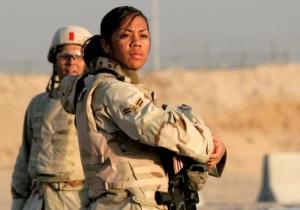
I still remember being told I should never walk around our base in Iraq alone. Would you believe that it didn’t even seem strange at the time?
Today I’m a public health researcher. A big part of what I do is try to figure out how to make the process of becoming a civilian again easier for military women. It’s a job I care about deeply because I recognize all too personally the health issues that come along with transition struggles. What I find in my research over and over again is that the biggest barrier to changing any of that struggle for military women as they become Veterans is this – we’re invisible.

We joke in the Marine Corps about “drinking the Kool-Aid,” which simply means thoroughly embracing the culture and lifestyle. Everything’s intense, and we’re demanding of ourselves and one another. This is especially true of the women who make up about 7 percent of the group. There’re so few of us that one represents all, and the standards are zero-defects and brutal.
I was in denial that institutional and social marginalization in the Marine Corps impacted all of us. Don’t get me wrong – there were hints on occasion that I wasn’t 100 percent part of this tribe that I loved, but I refused to recognize them. I simply tried to be perfect and emotion-free. I thought if didn’t use ramps to run the obstacle course, laughed at mildly-sexist comments, or brushed off that one Commanding Officer who liked to tell jokes about women drivers, I’d be part of the club.
And I love that club.
When it was time to leave active duty and go back to school and become a normal girl again, I thought it would be a breeze.
It wasn’t.
When I left the Marine Corps, I had a hard time carving a new identity for myself. I got in my own way some of the time. I was young, I was intense, I pushed myself hard and knew how to press the gas but never, never the brake.
This serves a lot of us well for a period of time. But what happens when you never turn the intensity off?
I didn’t know where to turn for a new social support system outside the active duty military. Particularly in the Veteran community, I didn’t fit in anywhere. I wasn’t going to tell jokes with the older Vets at the local VFW bar, and civilian settings didn’t feel any better – I didn’t have much in common with local women in junior league.
I was weird.
The very word “Veteran” calls to mind the image of a man for most people, especially combat Veteran. But there are over 1.6 million women veterans in the United States. Of these, 30% are post-9/11-era, meaning younger Veterans. Many of us served in Iraq and Afghanistan, We may be a sizable percentage of the women Vet population, but post 9-11 women Vets stand a bit apart in a normal crowd. (1)
In general, fewer Americans serve today. The American Veteran population (both male and female) has been declining for decades. What this means for my community of peers today is that only about 12% of young men and 3% of young women served during the last 15 years we’ve been at war. (2)
Women Veterans share many of the exact same concerns of our male colleagues; yet we also face unique issues, especially when it comes to accessing services after we leave active duty. Health care and other support systems (non-profit and government) often just weren’t built for us. We also leave the military with less social support, a very important protective factor for human health. The results aren’t always pretty for our health outcomes.
And yet – military women offer some of the best examples of resilient leadership out there. I know women Veterans who left the service with physical injuries and an assault history who went on to start businesses and nonprofits that try to help other warriors get wellness services they never received access to. A woman Marine started the Service Women’s Action Network to advocate for needed policy changes – it’s the only advocacy group in the country for active duty and Veteran women. We’re over-represented among small business owners, our college graduation rates are high, and we’re politicians like Sen Tammy Duckworth.
Mental health issues in the women Veteran community are as much about cohesion and support as they are about access to great treatment. So see us. Hire us. Make space in Veterans’ organizations, on your campuses, in your VA hospital. Recognize our experiences and unique needs and care enough about those to have us at the table when you’re planning your next Veteran outreach project. Are we in your board room?

Military women are some of the most resilient leaders you’ll meet, and you can change our reintegration experiences and our health outcomes if you help make that visible.
Notes:
- Veteran statistics are available from: https://www.va.gov/vetdata/veteran_population.asp
- Service rates have dropped:
- Friedman, J. (2015). Risk factors for suicide among Army personnel. Journal of the American Medical Association. 11, 1154-1155.
- Taylor, P. (2011). War and Sacrifice in the Post 9/11 Era: The Military-Civilian Gap. Pew Research Center Social and Demographic Trends.
Dr. Kate Hendricks Thomas is the author of Brave, Strong, True: The Modern Warrior’s Battle for Balance and co-author of Bulletproofing the Psyche.
ShareAPR
2019

About the Author: